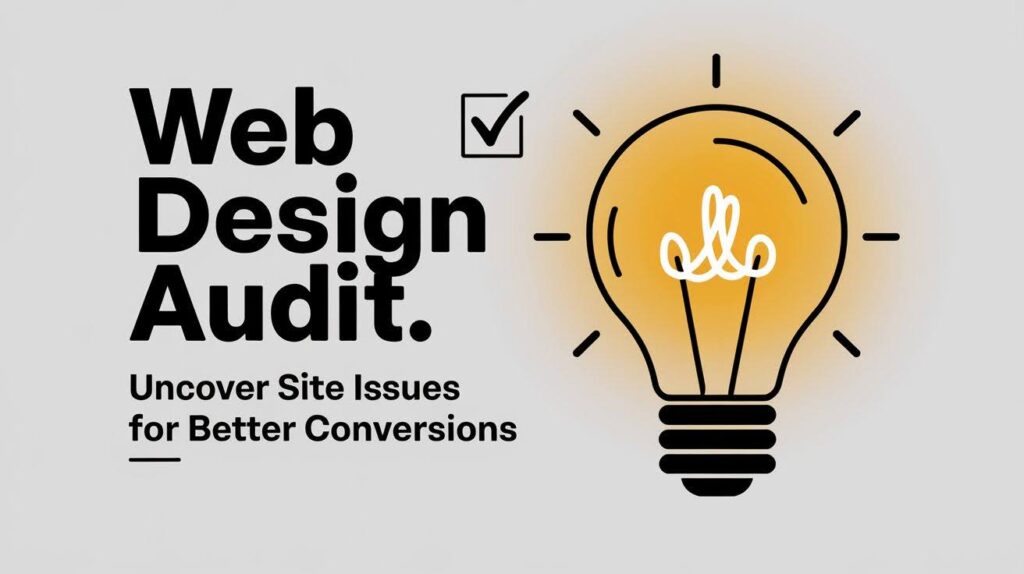
Introduction
A well-designed website is essential for capturing user attention, driving conversions, and building brand credibility. However, over time, even the most carefully crafted sites can develop pain points that hinder user experience and decrease effectiveness. This is where a web design audit comes into play.
By thoroughly evaluating your website’s design, usability, performance, and content, a design audit helps uncover hidden issues and areas for improvement. This process is key to optimizing your website and ensuring that it delivers a smooth user experience while achieving your business goals.
Pain Points in Web Design
When it comes to web design, there are several common pain points that can negatively impact user engagement, accessibility, and conversions. Identifying and addressing these issues is crucial for maintaining a high-performing website.
- Poor Navigation and Site Structure: Users should be able to find what they need quickly and easily. Confusing navigation menus, disorganized content, and broken links can frustrate visitors and lead to higher bounce rates.
- Slow Loading Times: A slow website can significantly impact user experience. Pages that take more than a few seconds to load can result in lost visitors, reduced conversions, and lower search engine rankings.
- Visual Inconsistencies: A lack of branding consistency, mismatched color schemes, or poorly chosen typography can make a website feel unprofessional. Users expect visual continuity that reflects your brand identity.
- Accessibility Issues: Websites that don’t meet Web Content Accessibility Guidelines (WCAG) may not be usable by individuals with disabilities. This limits your audience reach and may also lead to legal complications.
- Outdated or Irrelevant Content: Content that doesn’t meet user needs or is not optimized for SEO can hurt your website’s performance. Outdated information, broken links, or poorly written content diminishes trust and user satisfaction.
Types of Web Design Audits
There are different types of audits that each focus on a particular area of web design. Conducting the right type of audit for your site can help you uncover specific problems.
- UX Audit: Focuses on the user experience, evaluating how intuitive and enjoyable the site is to navigate. This audit reviews user flows, ease of navigation, and whether the design aligns with user expectations.
- Visual Design Audit: Looks at visual elements like typography, color schemes, imagery, and overall branding consistency. It ensures that all design elements work together to reflect your brand identity and resonate with your audience.
- Content Audit: Reviews the quality, relevance, and SEO optimization of your website’s content. This includes ensuring meta tags are correct, keywords are used effectively, and the content is up-to-date.
- Accessibility Audit: Ensures that your website meets legal and ethical accessibility standards. It involves checking for compliance with WCAG and ensuring that all users, regardless of ability, can interact with your site effectively.
- Performance Audit: Focuses on technical aspects such as page loading times, mobile responsiveness, and overall site functionality. Performance issues can affect user retention and search engine rankings.
For more comprehensive web audits, please contact our experienced team at 42Works.
How to Conduct a Web Design Audit

Conducting a web design audit involves several critical steps. By following these, you can identify and resolve the most significant pain points impacting your site’s performance.
- Step 1: Set Clear Goals
Determine what you hope to achieve with your audit. Whether it’s improving conversion rates, reducing bounce rates, or increasing overall traffic, having defined objectives will guide the process. - Step 2: Evaluate Usability
Test your website’s usability by walking through the user experience. Are the key pages easy to find? Is the site mobile-friendly? Are all elements responsive? These factors significantly impact how users interact with your site. - Step 3: Analyze Visual Design
Review the website’s visual elements, including typography, color schemes, and images. Ensure that these elements are consistent with your brand and contribute to a cohesive user experience. - Step 4: Review Content Quality
Evaluate whether your website’s content is relevant, accurate, and optimized for SEO. Make sure all headings, meta tags, and keywords are aligned with your target audience and that the content is engaging and easy to read. - Step 5: Test Accessibility
Run tests to ensure your site meets accessibility standards. Tools like WAVE or accessibility plugins can help you identify areas where your website might be excluding certain users. - Step 6: Assess Performance
Use tools like Google PageSpeed Insights or Lighthouse to test your site’s loading speed and performance. Address slow page loads, large file sizes, or any technical errors that could affect the user experience.
Tools to Assist in Web Design Audits
Several tools are available to help streamline the audit process, providing insights into specific areas of your website:
- Google Analytics: Offers data on user behavior, traffic sources, and conversion metrics. This tool helps you understand how users are interacting with your site.
- Hotjar: Provides heatmaps and user session recordings to reveal how users navigate your site. This data helps identify areas where users get stuck or confused.
- Lighthouse: A tool that provides automated performance audits focusing on site speed, accessibility, SEO, and more.
- Crazy Egg: Visualizes user interactions on your site, such as where they click, how far they scroll, and which areas receive the most attention.
- WAVE: A free tool for checking your site’s accessibility, ensuring it’s usable by individuals with disabilities and compliant with WCAG.
Conclusion
A web design audit uncovers hidden issues affecting your site’s performance. By evaluating usability, design, content, accessibility, and performance, it enables data-driven improvements that enhance user experience, boost conversions, and support business growth. Regular audits ensure your website stays functional and aligned with evolving user needs.
Need expert help? 42Works offers professional audits to identify pain points and optimize your site for maximum performance. Contact 42Works today to schedule your audit and unlock your website’s full potential!
FAQs
1. How often should I conduct a web design audit?
A web design audit should be done at least annually, or more frequently if you notice technical issues or declining performance.
2. What is the main goal of a web design audit?
The goal is to identify usability, design, and performance issues to improve user experience and boost conversions.
3. What tools do I need for a comprehensive web design audit?
Tools like Google Analytics, Hotjar, Lighthouse, and WAVE are key for analyzing traffic, behavior, SEO, and accessibility.
4. How can a web design audit improve my website’s conversion rate?
It identifies and resolves obstacles like poor navigation and slow load times, streamlining the user journey for higher conversions.5. Can I conduct a web design audit on my own, or should I hire a professional?
You can conduct basic audits yourself, but hiring a professional is recommended for in-depth, technical evaluations.


